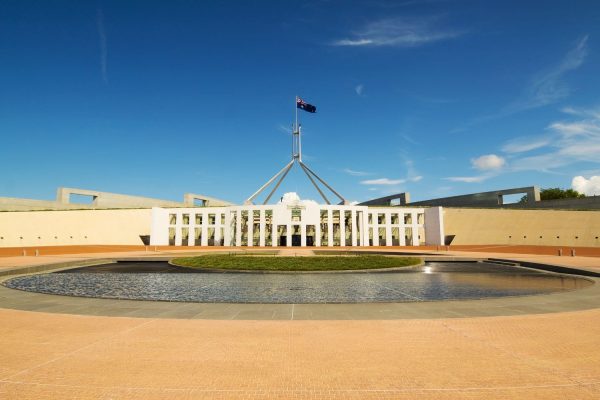Note. This is the transcript of the speech delivered by Associate Professor Sam Wilson at the inaugural Australian Leadership Summit hosted in Launceston, Tasmania (24-26 March 2024). Thanks to Andrea Hogg, Angela Driver, Joey Crawford, Giles Hirst, Toby Newstead and Ros Young for their kind invitation to be part of this unique Summit. Thanks also to Tasmanian Leaders, University of Tasmania, The Leadership Network, and the Australian National University for making this event possible.
Wither leadership for the common good?
It will not have escaped the attention of anyone here that public trust in our leaders and institutions has collapsed. Few institutions have been spared.
This collapse in trust affects institutions across the board, including those in the not-for-profit sector whose social mission might have been expected to provide some sort of buffer against the wave of distrust that has swept the institutional landscape.
Unsurprisingly, government and business institutions have fared the worst. Indeed, in the public mind, the institution of federal government is seen as little better than gaming companies and casinos, for whom a special circle of hell is reserved in the public imagination.
A major feature of this collapse in trust is the pervasive public sense, fair or otherwise, that leaders and institutions are more concerned with the pursuit of self and vested interests than they are with the long-term public interest or common good.
In this context, where commitment to the common good seems to be honoured more in the breach than the observance, people in Australia and around the world have come to yearn for moral leaders and institutions that value and are committed to serving the common good.
This is observed in the leadership literature too, with a growing body of literature devoted to the study of ethics, morality and leadership. Although the concept of the common good is occasionally used in this literature, perhaps most notably in the work of Barbara Crosby, John Bryson and colleagues in their studies of integrative public leadership, the concept of the common good is rarely defined. This begs the question, what is the common good?
What is the common good?
For people not conversant with philosophy, the meaning of the common good is self-evident; it refers to what the members of a community have in common or, alternatively, to those “goods” that serve the interests of all members of a community.
However, these simple formulations obscure more than they reveal. As I’ve come to learn over the years, the common good is, in fact, a complex normative concept with a long and contested history, replete with diverging and often contradictory meanings.
To make this survey of this concept relatively brief, I’ll restrict my attention to the common good as conceived in the Western tradition. Of course, the idea of the common good is found in many if not all cultures and traditions.
Moreover, in societies such as ours and others in the Anglosphere, the fact of ancient indigenous and other more recent non-Western traditions further enriches, and complicates, our conceptions of the nature, forms, and boundaries of the common good. My focus here on the common good in the Western tradition will, I hope, nevertheless suffice to illustrate the puzzle and paradox of the common good.
It is possible to discern at least five major approaches to thinking about the common good in the Western tradition.
Perhaps most ancient of all are “unitary” approaches to the common good which view it as synonymous with a higher purpose, such as God. On this view, the common good is objective, like a law of nature, and provides a natural or God-given goal for society and the politics within.
From the 17th century onwards, we witnessed the emergence of individualistic conceptions of the common good, as seen in “aggregative” approaches that conceptualise the common good as the sum of private goods, not a collective social goal, such as an ideal political community.
By contrast, “communitarian” approaches, which turn on collectivist notions of the common good, contend that it is more than the mere sum of private or individual goods. On this view, the common good is valuable in and of itself, even if one does not receive any personal benefit.
Consistent with the modern turn towards material well-being and away from concerns with moral virtue and an ideal vision of a good society, “civic” approaches emerged that view the common good as those “goods” that we all share as members of the public. These include public goods, such as roads and the rule of law, and common-pool resources, such are clean air and waterways. In contrast to other approaches, this approach to the common good does not convey or centre any sense of commonality or shared identity among individuals.
Finally, “procedural” approaches view the common good as the outcome of processes, procedures and practices enacted under ideal conditions. Think, for example, of citizens’ assemblies and other forms of deliberative democracy.
I hope this potted summary, despite its brevity, reveals that any given approach to, or perspective on, the common good is, at best, a partial representation of this complex concept.
Consistent with this, the philosopher Hans Sluga has argued that this panoply of normative conceptions means that there is, in fact, no single determinate common good. Although the common good has been the subject of normative theorising for millennia, this ancient idea is now widely regarded as an “essentially contested concept”, leading scholars to argue that a shared conception of the common good is out of our reach, at least via the normative route.
Folk conceptions of the common good
The view of ordinary people seems to be no less complicated than the view from philosophy. Drawing on over 14,000 open-ended free text responses to the question, “what is the common good?”, my colleagues and I recently found nine distinct themes in Australians’ beliefs about the common good.
There are three major things to note about our findings.
The first thing to note is that ordinary people tend to focus only one theme in their definition of the common good. For example, the definitions of some people highlight outcomes but not processes, whereas some focus on processes and principles but not the outcomes of these processes. Yet other people focus on the beneficiaries of the common good but have little to say about either outcomes or processes.
Second, among Australians at least, the common good seems to be viewed through a utilitarian rather than deontological lens, as suggested by the prevalence of such themes as ‘general public’, ‘population over individual’, ‘majority over minority’ and ‘group over individual’.
Finally, these nine themes point to a deeper conceptual structure in folk conceptions of the common good, suggesting that it involves, as I have already hinted, three interlocking concepts: namely, outcomes, processes, and beneficiaries.
I find it is helpful to think about these results, and indeed normative conceptions of the common good more generally, using the parable of the blind men and the elephant, all of whom discern some partial truth, as it were, of the elephant but none of whom can apprehend the whole. Each of these perspectives distil certain elements of experience and wisdom that are missed by the others, and each provides an expression of the way in which a considerable proportion of the community feels we should live with one another.
Understood in this way, the common good is not a single thing but, rather, more an umbrella term for several interlocking concepts and conditions that underpin the survival and flourishing of life. The common good is as much about process as it is about outcomes and the people who comprise the community for whom the good is sought, and reducible to no single aspect.
Paradoxes of the common good
In complex, pluralistic societies such as ours, there are reasonable differences of opinion about what is the right, just, or fair thing to do. These differences of opinion relate to a host of phenomena, including social goals and outcomes, the processes through which goals are realised, the nature of self and identity, and the extent to which we should build upon, abandon, or destroy the past to create the future.
Although these diverse perspectives point to often contradictory perspectives on the common good, they are all, nevertheless, in some sense ‘true’. They exist simultaneously, persist over time, and, ultimately, need each other. Characterised thus, the common good has all the hallmarks of paradox, defined as contradictory yet nonetheless true elements that exist simultaneously and persist over time.
The leadership scholar Richard Bolden and his colleagues have argued that people in Western cultures find paradoxes especially hard to understand and accept. When confronted with a paradox, the first impulse of many people is to try to resolve it; to reconcile the conflicting statements so that they agree, removing the apparent contradiction.
However, the central point to be made about paradoxes is that they are not opposites that can be reconciled dialectically or puzzles to be solved; they simply are.
According to management scholars Wendy Smith and Marianne Lewis, paradoxes can be categorised into four basic types: paradoxes of performing, organising, learning, and belonging. This typology can be helpfully recruited to make sense of the many paradoxes of right versus right that characterise the common good. I’ll briefly consider each type of paradox in turn to illustrate the manifestations of these paradoxes in our lives.
Paradoxes Of Performing
Performing paradoxes emerge in the context of diverse stakeholders and result in competing goals and outcomes. Consider, for example, Dana Meadows’ sustainability framework that relates natural resources to human well-being through human, social, financial, and built capital. Although all capitals are important, and although it is important to maintain stocks of all capitals, doing so is not straightforward because the goal of maximising one type of capital, such as financial capital, is often in tension with the goal of maximising other types, such as, natural capital. This societal-level tension is recapitulated at the organisation level, such as between the goals of profit and social responsibility, and at the individual level, as evidenced by the conflicting demands experienced by social entrepreneurs that stem from their dual commitments to improving social welfare and achieving commercial viability. More abstractly, consider the paradoxical tensions that inhere between conceptions of the good that foreground liberty and freedom and those that give primacy to security and order.
Paradoxes Of Organising
Organising paradoxes arise as complex systems create competing processes to achieve desired goals and outcomes. These paradoxes call attention to the range of legitimate processes that can be recruited in the search for the common good. For example, we can envisage the search for the common good in various ways: as cooperative or competitive, as centralised or decentralised, or as traditional or freely constituted. Indeed, as revealed by the work of anthropologists such as Alan Fiske, humans have evolved a range of relational modes and moral motives for solving the problem of cooperation in our search for the common good. While all are ‘natural’, these modes and ways of life don’t always pull in the same direction.
Paradoxes Of Learning
Learning paradoxes surface as dynamic systems adapt, change, renew, and innovate. This raises challenging questions about whether to build upon, abandon, or destroy the past in order to create the future. In essence, this reflects the tension between continuity and change. The political arena is the domain in which the drama between continuity and change is played out most obviously, as reflected in the competition between worldviews that seek to conserve or incrementally build upon tradition and those that strive for progress by destroying the past. I’ll return to this theme later to illustrate the challenges of leadership for the common good.
Paradoxes Of Belonging
Belonging paradoxes pertain, among other things, to the nature of self and identity. Consider, for example, the tensions that exist between the individual and the group or, put differently, between individual and collective interests. This tension creates the fundamental moral problem of cooperation, which is getting a pair or a group of people to do what’s best for the group as opposed to what is best for the individual. Leadership scholars Donelson Forsyth and Crystal Hoyt call this ‘Me’ versus ‘Us’ problem the “master problem” of social life.
However, it is important to note, as pointed out by social psychologists like Jonathan Haidt and Joshua Greene, that the moral decisions that are made within our “moral tribes” are very different than those that are made between tribes. The key insight here is that our moral intuitions evolved to solve the recurrent Me versus Us problems encountered within our tribes.
They did not evolve to solve our now pressing, but relatively novel, Us versus Them problems. Thus, although our moral intuitions serve us well when deciding how, and how not, to act within our tribes, they can be downright counterproductive in the context of the problems we now habitually encounter in complex, pluralistic societies; namely, recurrent tensions between different tribes that must somehow co-exist and cooperate within the same society.
As testament to this, we need only consider the fact that Western societies are becoming increasingly polarised. As revealed by the Edelman Trust Barometer, the US is now severely polarised. Countries such as the UK, France, and the Netherlands are in danger of severe polarisation. And, unhappily, countries such as Canada, Ireland, and now Australia are on a path to polarisation.
Addressing the problem of polarisation, which is so corrosive of our social institutions, including the institution of civil society, is a core challenge of leadership for the common good in the coming years.
Moreover, and this is relevant to the broader leadership development theme of this Summit, an important part of this involves us creating what Joshua Greene calls a “meta-morality”. We are all familiar with the concept of morality, but perhaps not the concept of meta-morality. As Greene explains, a morality is what allows the individuals within a group to get along, to turn a bunch of separate Me’s into an Us. A meta-morality performs the same function at a higher level, allowing groups to get along. Just as a first-order moral system adjudicates among competing individuals, a meta-morality adjudicates among competing moral systems.
Leadership and the search for the common good
To this point, I have been quite abstract in my treatment of the meanings and paradoxes of the common good and the challenges posed by competing moral systems. I would, therefore, like to conclude by showing more plainly and concretely why leadership for the common good is so challenging in the context of competing moral systems and conceptions of the good.
I will try to focus on something that is germane to both professional and everyday leadership for the common good in order to draw attention to the types of moral maps and paradoxical leadership practices that need to be developed in our search for common ground and the common good. To make this really concrete and relevant to the Australian context, I’ll ground my comments in one of the recurrent findings of the Australian Leadership Index.
Time and time again, across a range of institutions, we find that public perceptions of integrity is a key predictor of public perceptions of institutional leadership for the common good. Furthermore, the types of variables that consistently predict integrity are things like “treating everyone fairly”, “behaving ethically” and “acting in the best interests of society”.
On the face of it, the prescription to treat people fairly, behave ethically and act in the best interests of society seems quite straightforward, and perhaps it is in the context of single moral tribes. However, in the context of competing moral tribes, with competing conceptions of the common good, the question of what it means to treat people fairly, behave ethically and act in the best interests of society is not easy or straightforward at all.
For example, what does it really mean to “treat people fairly”? The answer to this question seems to depend in part on one’s moral and philosophical worldview.
To help make sense of and elaborate this point, it is helpful to draw on a new framework proposed by sociologists John Iceland and Eric Silver. This framework, which delineates two basic worldviews, which they call Social Justice and Social Order, can help us see why it is so hard to act and lead in a way that is universally judged as serving the common good.
Let me offer a simple example to illustrate this point.
Everyone cares about fairness. However, there are two major kinds of fairness, and these are differentially endorsed by people with Social Justice and Social Order worldviews, partly because these worldviews are grounded in distinct moral intuitions. To illustrate, whereas a person with a Social Justice worldview tends to think about fairness in terms of outcomes, a person with a Social Order worldview tends to think about fairness in terms of processes.
Corresponding differences are observed in how equality is understood. Consistent with their focus on outcomes, a person with a Social Justice perspective tends to think about equality in terms of equality of outcome, viewing inequalities of outcome as the result of unjust discrimination.
By contrast, a person with a Social Order worldview, who tends to think about equality in terms of proportionality, emphasizes equality of opportunity, viewing variation in outcomes as the result of individual differences in talent, effort, preferences and, ultimately, choices.
Thus, although fairness and equality are important for both moral tribes, the meaning ascribed to these concepts is completely different. A raft of other differences seem to obtain between these moral tribes which relate to freedom, choice and responsibility, the importance of individual and group identity, and the pace and scale of social change. All these things further complicate what it means to lead, and be judged to lead, in the service of the common good.
As I hope is now clear, understanding the meaning of leadership for the common good in societies like ours requires more than a sound understanding of the relationship between morality and leadership. This, of course, is necessary, but it is not sufficient. What is also needed is an understanding of meta-morality and leadership.
Although we might grasp the concept of meta-morality in the abstract and have a growing appreciation of the need for it, witnesses as we are to growing polarisation in our midst, we do not yet have a meta-morality. It remains something of a vague and distant ideal.
I suggest that a worthy, if wildly ambitious, goal of leadership for the common good in the coming years is to discover and create this meta-morality. As part of this, we need to foster the capability and culture required to support this goal in our organisations and communities, and, most critically, in our politics.
Doing so is central to our ability to talk across moral and political divides and, ultimately, to our ability to foster the conditions and life-support systems that underpin the survival and flourishing of life.




